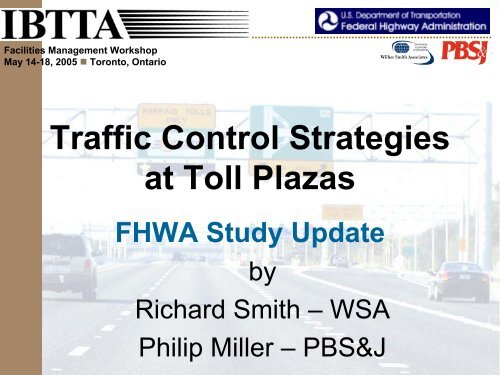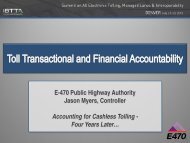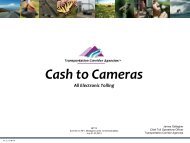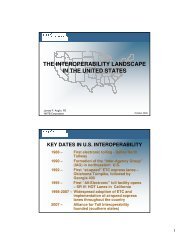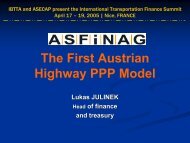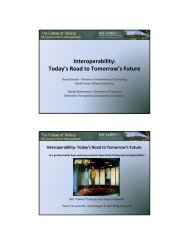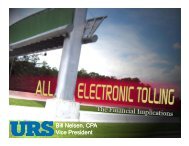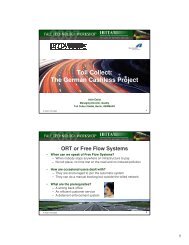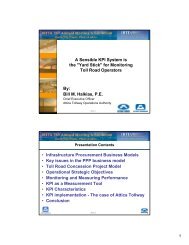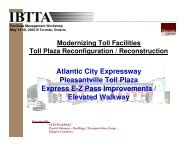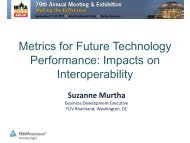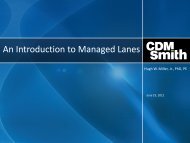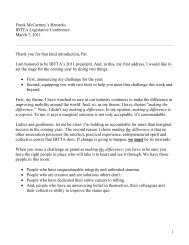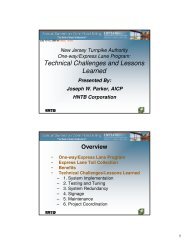Traffic Control Strategies at Toll Plazas - International Bridge, Tunnel ...
Traffic Control Strategies at Toll Plazas - International Bridge, Tunnel ...
Traffic Control Strategies at Toll Plazas - International Bridge, Tunnel ...
You also want an ePaper? Increase the reach of your titles
YUMPU automatically turns print PDFs into web optimized ePapers that Google loves.
Facilities Management Workshop<br />
May 14-18, 2005 • Toronto, Ontario<br />
<strong>Traffic</strong> <strong>Control</strong> <strong>Str<strong>at</strong>egies</strong><br />
<strong>at</strong> <strong>Toll</strong> <strong>Plazas</strong><br />
FHWA Study Upd<strong>at</strong>e<br />
by<br />
Richard Smith – WSA<br />
Philip Miller – PBS&J
Facilities Management Workshop<br />
May 14-18, 2005 • Toronto, Ontario<br />
Study Team<br />
• Manager: Linda Brown (FHWA Office of<br />
<strong>Traffic</strong> Oper<strong>at</strong>ions),<br />
• Steering: Kerry Ferrier (Ohio Turnpike),<br />
Neil Gray (IBTTA),<br />
• First round reviewers: Roxane Mukai<br />
(Maryland Transport<strong>at</strong>ion Authority), Pete<br />
Gustafson (New York Thruway) & Susan<br />
Chrysler (TTI),<br />
• Consultants: B<strong>at</strong>telle Institute,<br />
Wilbur Smith Associ<strong>at</strong>es (Study Lead),<br />
PBS&J, and Terry Geohegan.<br />
Slide 2
Facilities Management Workshop<br />
May 14-18, 2005 • Toronto, Ontario<br />
Present<strong>at</strong>ion Outline<br />
• Study Objectives,<br />
• Purpose and Need,<br />
• Study Approach,<br />
• Some Key Findings,<br />
• Wh<strong>at</strong> Happens Next.<br />
Slide 3
Facilities Management Workshop<br />
May 14-18, 2005 • Toronto, Ontario<br />
Study Objectives<br />
• A consistent plaza traffic str<strong>at</strong>egy,<br />
• Enhanced plaza safety and oper<strong>at</strong>ions,<br />
• Improve plaza efficiency,<br />
• Improve driver recognition and reaction.<br />
Slide 4
• Identify and define current practices,<br />
• Develop guidelines based on multiple<br />
sources of inform<strong>at</strong>ion,<br />
• Strive to achieve consensus (amongst toll<br />
agencies) by soliciting comments to draft<br />
report,<br />
• Prepare Best Practices Report th<strong>at</strong><br />
identifies the st<strong>at</strong>e of the practice and<br />
presents guidelines for selecting and<br />
installing traffic control devices.<br />
Slide 5<br />
Facilities Management Workshop<br />
May 14-18, 2005 • Toronto, Ontario<br />
Purpose and Need
Facilities Management Workshop<br />
May 14-18, 2005 • Toronto, Ontario<br />
Purpose and Need (Cont.)<br />
• No uniform standards or guidelines.<br />
Individual agencies employ their own<br />
designs to meet individual needs,<br />
• Introduction of ETC dedic<strong>at</strong>ed and express<br />
lanes adds complexity by increasing<br />
payment options and speed vari<strong>at</strong>ion,<br />
• Higher-speed traffic diverging <strong>at</strong> express<br />
lane gore, and then merging and weaving<br />
before entering a toll lane and merging after<br />
exiting the toll lane.<br />
Slide 6
Facilities Management Workshop<br />
May 14-18, 2005 • Toronto, Ontario<br />
Study Approach<br />
1. Liter<strong>at</strong>ure Search on <strong>Toll</strong> Plaza Design and<br />
<strong>Traffic</strong> <strong>Control</strong> Devices,<br />
2. <strong>Toll</strong> Agency Survey,<br />
3. Expert Panel Workshop to assess<br />
applicability of research and efficacy of<br />
survey d<strong>at</strong>a in initi<strong>at</strong>ing guideline<br />
development,<br />
4. Consensus Building to Develop a Best<br />
Practices Report.<br />
Slide 7
Facilities Management Workshop<br />
May 14-18, 2005 • Toronto, Ontario<br />
1. Liter<strong>at</strong>ure Search<br />
• Sources of d<strong>at</strong>a included:<br />
– NCHRP Synthesis of Highway Practice #<br />
240: <strong>Toll</strong> Plaza Design (1997),<br />
– Plaza Design research in the Journal of<br />
Transport<strong>at</strong>ion Engineering,<br />
– Oper<strong>at</strong>ions research printed in the ITE<br />
Journal,<br />
– <strong>Toll</strong> plaza design standards from several<br />
toll agencies.<br />
Slide 8
• 260 questions per facility type on plazas,<br />
lane assignments, signing, traffic control<br />
device placement,<br />
• Scripted questions using JAVA and hosted<br />
on Wilbur Smith Associ<strong>at</strong>es Web site<br />
requiring access authentic<strong>at</strong>ion,<br />
• Agency survey response period was May –<br />
July 2004,<br />
• Initial responses came from 28 agencies (19<br />
highway, 10 bridge, one also oper<strong>at</strong>es<br />
tunnel crossings). Slide 9<br />
Facilities Management Workshop<br />
May 14-18, 2005 • Toronto, Ontario<br />
2. <strong>Toll</strong> Agency Survey
Facilities Management Workshop<br />
May 14-18, 2005 • Toronto, Ontario<br />
3. Expert Panel Workshop<br />
• Held in Illinois in August 2004,<br />
• In addition to project team, <strong>at</strong>tended<br />
by:<br />
– Sam Wolfe (Indiana <strong>Toll</strong> Road),<br />
Mike Davis (Florida’s Turnpike),<br />
– Consultants David MacDonald, Greg<br />
LeFrois, Glenn Havinoviski, Raghu<br />
Kowshik, George Scheuring.<br />
Slide 10
Facilities Management Workshop<br />
May 14-18, 2005 • Toronto, Ontario<br />
4. Best Practices Report<br />
• Synthesis of input from earlier activities,<br />
• First draft in December 2004,<br />
• First review comments by selected FHWA<br />
panel were received and addressed in<br />
second draft,<br />
• Second draft to be distributed for review<br />
comments by toll agencies and others in<br />
May 2005,<br />
• Agency review comments reconciled and<br />
addressed with final report issued in<br />
August 2005.<br />
Slide 11
Facilities Management Workshop<br />
May 14-18, 2005 • Toronto, Ontario<br />
Key Findings: Plaza/Lane Configur<strong>at</strong>ions<br />
• ETC Dedic<strong>at</strong>ed Lanes:<br />
– 92% of respondents have ETC dedic<strong>at</strong>ed lanes,<br />
– 83% of respondents have multiple ETC dedic<strong>at</strong>ed<br />
lanes,<br />
– 46% of respondents with ETC dedic<strong>at</strong>ed lanes in<br />
opposing direction of traffic, separ<strong>at</strong>e th<strong>at</strong> traffic with<br />
concrete barrier,<br />
– 13% of respondents with multiple ETC dedic<strong>at</strong>ed<br />
lanes restrict those lanes to cars,<br />
– ETC dedic<strong>at</strong>ed lane posted speeds range from 5<br />
mph to 45 mph (8 to 70 kph).<br />
Slide 12
Facilities Management Workshop<br />
May 14-18, 2005 • Toronto, Ontario<br />
Key Findings: Plaza/Lane Configur<strong>at</strong>ions<br />
• ETC Dedic<strong>at</strong>ed Lanes:<br />
Slide 13
Facilities Management Workshop<br />
May 14-18, 2005 • Toronto, Ontario<br />
Key Findings: Plaza/Lane Configur<strong>at</strong>ions<br />
• ETC Dedic<strong>at</strong>ed Lanes:<br />
– Dedic<strong>at</strong>ed lane loc<strong>at</strong>ion must consider many<br />
factors th<strong>at</strong> vary based on plaza type and loc<strong>at</strong>ion<br />
– in this picture, in an interchange area.<br />
Slide 14
Facilities Management Workshop<br />
May 14-18, 2005 • Toronto, Ontario<br />
Key Findings: Plaza/Lane Configur<strong>at</strong>ions<br />
• ETC Express Lanes:<br />
– 91% of agencies responding to questions about<br />
express lanes have ETC express lanes (39% of all<br />
respondents to any questions),<br />
– Of respondents with express lanes, 91% loc<strong>at</strong>e their<br />
express lanes to the left,<br />
– All express lane oper<strong>at</strong>ors allow all classes of<br />
vehicles to use express lanes – with one exception.<br />
– Express lanes are typically posted <strong>at</strong> speeds gre<strong>at</strong>er<br />
than or equal to 55 mph (90 kph).<br />
Slide 15
Facilities Management Workshop<br />
May 14-18, 2005 • Toronto, Ontario<br />
Key Findings: Plaza/Lane Configur<strong>at</strong>ions<br />
• ETC Express Lanes:<br />
Slide 16
Facilities Management Workshop<br />
May 14-18, 2005 • Toronto, Ontario<br />
Key Findings: Plaza/Lane Configur<strong>at</strong>ions<br />
• ETC Express Lanes:<br />
Slide 17
• Gre<strong>at</strong>er use of lane type (i.e., manual,<br />
autom<strong>at</strong>ic, ETC dedic<strong>at</strong>ed) clustering,<br />
• Use of branch / s<strong>at</strong>ellite plazas is<br />
decreasing (only 7% of respondents), but<br />
• 41% of respondents use reversible lanes,<br />
– Needed for constrained plazas, such as those on<br />
ticket system interchanges,<br />
– Facilities with reversible roadways,<br />
– Insufficient ETC market penetr<strong>at</strong>ion resulting in<br />
need for more cash lanes during peak traffic<br />
periods. Slide 18<br />
Facilities Management Workshop<br />
May 14-18, 2005 • Toronto, Ontario<br />
Key Findings: Plaza/Lane Configur<strong>at</strong>ions
Facilities Management Workshop<br />
May 14-18, 2005 • Toronto, Ontario<br />
Key Findings: Approach Signing<br />
• Needed for plazas with separ<strong>at</strong>ed express lanes,<br />
• Desirable for plazas with ETC dedic<strong>at</strong>ed lanes,<br />
• Currently not addressed in MUTCD,<br />
• Existing types, colors and legends vary<br />
substantially from agency to agency,<br />
• Most agencies <strong>at</strong>tempt to differenti<strong>at</strong>e between<br />
express lanes and conventional plaza lanes,<br />
• Report guideline recommends an approach signing<br />
sequence similar to th<strong>at</strong> for an interchange.<br />
Slide 19
Facilities Management Workshop<br />
May 14-18, 2005 • Toronto, Ontario<br />
Key Findings: Approach Signing<br />
Slide 20
Facilities Management Workshop<br />
May 14-18, 2005 • Toronto, Ontario<br />
Key Findings: <strong>Toll</strong> Lane Signing<br />
• 87% of responding agencies use canopy signing<br />
for identifying ETC dedic<strong>at</strong>ed lanes,<br />
• 71% of responding roadway agencies use fixed<br />
panel signs, 43% of responding bridge agencies<br />
use fixed panel signs. Others are variable,<br />
• Changeable message signs are used by some<br />
agencies, ranging from full deployment above all<br />
plaza lanes to partial deployment above lanes<br />
supporting multiple forms of payment,<br />
• Flashing yellow beacon is most commonly used<br />
method for highlighting ETC dedic<strong>at</strong>ed lanes.<br />
Slide 21
Facilities Management Workshop<br />
May 14-18, 2005 • Toronto, Ontario<br />
Key Findings: <strong>Toll</strong> Lane <strong>Traffic</strong> <strong>Control</strong><br />
• 42% of responding agencies use stop signs in<br />
<strong>at</strong>tended or autom<strong>at</strong>ic coin lanes,<br />
• 4% of responding agencies use speed display<br />
signs to control traffic speeds through the toll lane,<br />
• Majority of agencies use an Island traffic signal to<br />
control travel through the toll lane and a p<strong>at</strong>ron toll<br />
display in <strong>at</strong>tended lanes to display toll due,<br />
• 25% of responding roadway agencies use g<strong>at</strong>es in<br />
ETC dedic<strong>at</strong>ed lanes.<br />
Slide 22
Facilities Management Workshop<br />
May 14-18, 2005 • Toronto, Ontario<br />
Key Findings: Geometrics<br />
• The average taper r<strong>at</strong>e reported by the responding<br />
agencies is approxim<strong>at</strong>ely 1:10 for both the<br />
approach and departure zones,<br />
• The average length of both the approach and<br />
departure zones reported by the toll agencies is<br />
approxim<strong>at</strong>ely 500 feet,<br />
• For 91% of the responding agencies, the express<br />
lanes are a continu<strong>at</strong>ion of the mainline lanes. At<br />
least 64% of the responding agencies use concrete<br />
barrier on both sides of the express lanes,<br />
• The average lane width for manual, autom<strong>at</strong>ic and<br />
ETC dedic<strong>at</strong>ed lanes 11 feet and 12 feet for express<br />
lanes.<br />
Slide 23
Facilities Management Workshop<br />
May 14-18, 2005 • Toronto, Ontario<br />
Key Findings: Geometrics<br />
• The average width of a toll island<br />
supporting manual collection is 6.5 feet, and<br />
5.5 feet for a toll island supporting an<br />
autom<strong>at</strong>ic coin machine (ACM) or ATIM,<br />
• 52% of the responding agencies use a<br />
standard pole, mast arm and luminaire to<br />
light the plaza approach and departure<br />
zones.<br />
Slide 24
Facilities Management Workshop<br />
May 14-18, 2005 • Toronto, Ontario<br />
Key Findings: Equipment<br />
• ETC equipment is installed in all ACM &<br />
ATIM lanes for 55% of the the respondents,<br />
• 63% of the responding agencies purchased<br />
an ACM with an integral fare display,<br />
• In <strong>at</strong>tended lanes, the average distance<br />
from the centerline of tollbooth to the island<br />
traffic signal is 15 feet. The average<br />
mounting height of the ITS is 4.5 feet and a<br />
8 inch diameter signal head is used by 69%<br />
of the responding agencies.<br />
Slide 25
Facilities Management Workshop<br />
May 14-18, 2005 • Toronto, Ontario<br />
Key Findings: Equipment<br />
• 58% of the responding agencies include a<br />
yellow/amber signal head with the ITS to<br />
display ETC account balance inform<strong>at</strong>ion,<br />
• 75% of the responding agencies use a PTD<br />
in their <strong>at</strong>tended lanes and 50% use a PTD<br />
in their autom<strong>at</strong>ic lanes,<br />
• Although a wide distance range was<br />
reported, a distance of 4 feet from tollbooth<br />
centerline to PTD was selected the most.<br />
Slide 26
Facilities Management Workshop<br />
May 14-18, 2005 • Toronto, Ontario<br />
Key Findings: Equipment<br />
• A PTD size of 12”X 12” was the most commonly<br />
reported size. The average mounting height of the<br />
PTD above the island is approxim<strong>at</strong>ely 4.5 feet.<br />
54% use LED and 38% use flip disk technology,<br />
• Approxim<strong>at</strong>ely one-half of the responding agencies<br />
use barrier g<strong>at</strong>es in both their autom<strong>at</strong>ic and<br />
<strong>at</strong>tended lanes. 79% use loops to monitor g<strong>at</strong>e<br />
closure th<strong>at</strong> is supplemented by a photoelectric<br />
beam for 60% of the agencies,<br />
• VES cameras are used to capture viol<strong>at</strong>or license<br />
pl<strong>at</strong>es for 78% of the agencies in dedic<strong>at</strong>ed lanes<br />
and 83% of the agencies in express lanes.<br />
Slide 27
Facilities Management Workshop<br />
May 14-18, 2005 • Toronto, Ontario<br />
Wh<strong>at</strong> Happens Next<br />
• Distribution of Best Practices Report to Agencies<br />
and Others: May 2005<br />
• Agency review and comments returned: May – July<br />
2005<br />
• Team reconcile and address review comments:<br />
July – August 2005<br />
• Final Report prepar<strong>at</strong>ion and distribution: August<br />
2005<br />
• Report Present<strong>at</strong>ion to FHWA: August – September<br />
2005<br />
Slide 28
Facilities Management Workshop<br />
May 14-18, 2005 • Toronto, Ontario<br />
Thank You!


